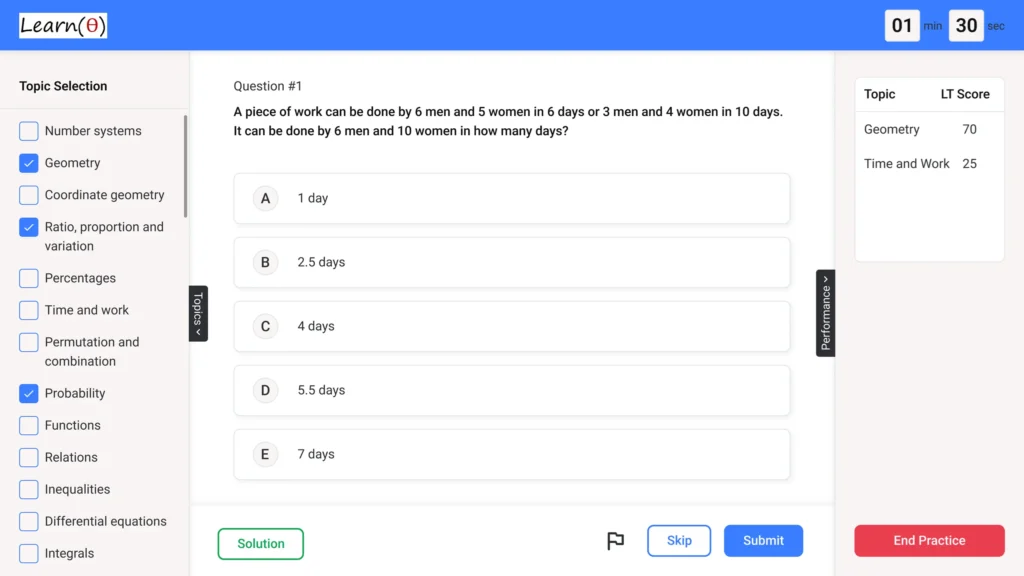Axtria – Aptitude Questions & Answers for Placement Tests
Reviewing Previous Year Questions is a good start. Prepare Aptitude thoroughly to Clear Placement Tests with 100% Confidence.
Q.1 A container initially holds 100 litres of a mixture of milk and water, with the ratio of milk to water being 3:2. ‘x’ litres of the mixture are removed and replaced with an equal amount of pure milk. This process is repeated once more. If the final ratio of milk to water in the container is 9:1, what is the value of ‘x’?
Check Solution
Ans: C
Initially, Milk = 60 litres, Water = 40 litres. After first removal and replacement: Milk remaining = 60 – (3/5)x + x = 60 + (2/5)x Water remaining = 40 – (2/5)x After second removal and replacement: Milk remaining = [60 + (2/5)x] – (3/5)[60 + (2/5)x] + x = 60 + (2/5)x – 36 – (6/25)x + x = 24 + (19/25)x Water remaining = 40 – (2/5)[60+(2/5)x] = 40 – (2/5)(40 – (2/5)x) = 40 – (2/5)(2/5)x Final ratio is 9:1 So, [24 + (19/25)x] / [40 – (2/5)x] = 9/1 = [40-(2/5)x] 24 + (19/25)x = 9 * [40-(2/5)x] 24 + 19x/25 = 36 -18x/5 24 + 19x/25 = 36-90x/25 19x + 90x = (36-24)*25 109x = 12*25 109x = 300 [24 + (19/25)x] / [40 – (2/5)x] = 9/1 24 + (19/25)x = 9*[40-(2/5)x] 24 + (19/25)x = 360 – (18/5)x 24 + (19/25)x = 360 – (90/25)x 19x + 90x = 360*25 – 24*25 109x = 336*25. WRONG. Milk after first process: 60 – (3/5)x + x = 60 + 2x/5. Water after first process: 40 – 2x/5. Milk after second process: [60+2x/5] – (3/5)[60+2x/5] + x = [60+2x/5] – 36 – 6x/25 + x = 24 + 10x/25 + x = 24 + 35x/25 Water after second process = 40 – 2x/5 -2/5[40-2x/5] [24 + 35x/25] / [40 – 2x/5 – (2/5)(40-2x/5)] = 9/1 So after first time: (3/5) of x is removed Milk= 60-(3x/5)+x= 60+2x/5 Water = 40 – 2x/5 milk 60+2x/5 and water 40-2x/5 After second removal and replacement with milk: milk=[60+2x/5]-(3/5)[60+2x/5]+x=60+2x/5-36-6x/25+x=24+(16+25)x/25=24+31x/25 water=[40-2x/5]-(2/5)[40-2x/5]=40-2x/5-16+4x/25=24-6x/25 [24+31x/25]/[24-6x/25]=9 24+31x/25=9(24-6x/25) 24+31x/25=216-54x/25 85x/25=192 x=192*25/85= 192*5/17 [24 + (19/25)x] / [40 – (2/5)x] = 9/1 (24+19x/25)=9[40-2x/5] 24+19x/25 = 360-18x/5 19x/25 +90x/25 = 336 109x=336*25 After first removal and replacement with milk: Milk = 60 – (3/5)x + x = 60 + (2/5)x. Water = 40 – (2/5)x After the second removal and replacement: Milk = [60 + (2/5)x] – (3/5)[(60 + (2/5)x)] + x = 60 + (2/5)x – 36 – (6/25)x + x = 24 + (19/25)x Water = 40 – (2/5)x – (2/5)[40 – (2/5)x] = 40 – (2/5)x – 16 + (4/25)x = 24 – (6/25)x So, [24 + (19/25)x] / [24 – (6/25)x] = 9/1 24 + (19/25)x = 9(24 – (6/25)x) 24 + (19/25)x = 216 – (54/25)x (73/25)x = 192 x= 192 *25 / 73 = 65.75 [24 + (19/25)x]/[40 – 2x/5 – 2/5 * (40 – 2x/5)] = 9/1 60/100=3/5 and 40/100=2/5. 1. removed x from 100. mix: 60, 40 New mix [60-3/5x]+x and [40-2/5x] Milk: 60+2/5x, water 40-2/5x Removed x, replace with milk Milk [60+2/5x]-3/5(60+2/5x) + x = 60+2/5x-36-6/25x+x = 24+1/5x(10-6+25) = 24+29x/25 Water 40-2/5x-2/5(40-2/5x)=40-2x/5-16+4/25x=24-6/25x 24+29x/25/24-6/25x = 9 24+29x/25=9(24-6x/25) 24+29x/25=216-54x/25 83x/25=192 x=192*25/83 [60 – (3/5)x + x] and [40 – (2/5)x] after first step. Milk 60 + (2/5)x, Water 40- (2/5)x [60+2/5x]-(3/5)[60+2/5x] +x, [40-(2/5x)]-2/5[40-(2/5x)] = 24 + (19/25)x, 24-(6/25)x 24 + 19/25 x / 24-6/25 x = 9/1 24+(19/25)x = 216-54/25 x 83/25 x = 192 x = 4800/83. Milk = 60, Water=40 Milk = 60-(3/5)x +x, water = 40-(2/5)x Milk = 60+2/5 x Water = 40-2/5 x [Milk-(3/5)(Milk)+x] / [Water-2/5(Water)] After removing x and replacing with milk Milk is 60 – (3/5)x+ x = 60+(2/5)x Water is 40-(2/5)x milk-[3/5(milk)] + x, water-(2/5(water)) [60+2/5x] – 3/5(60+2/5x)+x Milk: [60-(3/5)x +x ]* milk +x = 60-3x/5+x+x= 60+2x/5 water= 40-2x/5 Milk-(3/5)milk+x= 60+2x/5 – 3/5 * 60+2/5x+x=60+2x/5-36-6/25+x=24+31/25 x After 2nd replacement with milk Milk is 60-(3/5)x +x = 60+2/5 x water is 40-2x/5 milk is (60+2/5x) – 3/5 * 60+2/5x + x water 40-2x/5 -2/5 (40-2/5x) final ratio = 9/1 [60+2x/5 – (180+6x/5)/5]+x [60+2/5x – 36 -6/25x +x ] =24+29/25 x After second replacement Milk remaining = 60+2x/5 – (3/5)(60+2/5x)+x = 24 +19/25 x Water remaining = 40 – 2x/5- (2/5)(40-2x/5)=24-6/25x 24 + 19/25 x / 24-6/25 x = 9 19x/25 – 9*(-6x/25) = 9*24-24 x= 192*25/83 [24 + (19/25)x ]/[24-(6/25)x] = 9/1 19x/25+54x/25=216-24 73x/25=192 x=192*25/73 First removal: milk=3*100/5 milk 3*x/5, water=2/5 x mix : 3/5=60, 2/5=40, after replace 60+x/5 milk: 3/5 water 2/5x milk: 60-3x/5+x = 60+2x/5 water= 40-2x/5 after process: milk is 60 + (2x/5)-3/5[60 + 2x/5] +x =24 + (19/25)x water = 40-(2/5)x -2/5[40-2/5 x] = 24-6/25 x [24+19/25 x] / 24-6/25x=9/1 x= 192*25/73 Milk (60-3x/5)+x= 60+2x/5 water 40 -2x/5 [60+2x/5]/[40-2x/5]= 9/1 24+19/25 x/24-6/25 x=9/1 3/5, 2/5 60 + 2/5*x water 40 -2x/5 [60+2x/5 – 3/5 (60+2x/5) + x ]/[40-2x/5 – 2/5 (40-2x/5)] = 9/1 24+19x/25 /24-6x/25 = 9 x= 192*25/73 x = 20
Q.2 The respective ratio of sides of two squares (P and Q) is 3 : 4. The respective ratio of areas of squares P and Q is 9:16. What is the respective ratio of their perimeters?
Check Solution
Ans: B
Let the sides of square P and Q be 3x and 4x respectively. Then the areas are (3x)^2 and (4x)^2 which is 9x^2 and 16x^2. The ratio of areas is 9:16. Perimeter of P = 4 * 3x = 12x, Perimeter of Q = 4 * 4x = 16x. Ratio of perimeters is 12x:16x or 3:4.
Q.3 A shopkeeper bought a certain number of apples. He sold 20% of them to a customer A. He then sold 25% of the remaining apples to customer B. After that, he sold 30% of the remaining apples to customer C. Finally, the shopkeeper was left with 168 apples. How many apples did he buy initially?
Check Solution
Ans: A
Let the initial number of apples be x. After selling to A: x – 0.2x = 0.8x After selling to B: 0.8x – 0.25(0.8x) = 0.8x – 0.2x = 0.6x After selling to C: 0.6x – 0.3(0.6x) = 0.6x – 0.18x = 0.42x So, 0.42x = 168 x = 168 / 0.42 = 400
Q.4 18.005 * (35.002 / 7.001) = ?
Check Solution
Ans: A
18.005 * (35.002 / 7.001) ≈ 18 * (35 / 7) = 18 * 5 = 90
Q.5 29.98/4.02 – 89.97/15.01 = ?
Check Solution
Ans: B
30/4 – 90/15 = 7.5 – 6 = 1.5, which is closest to 1
Q.6 2/3 of 5/8 of 12/25 of 600 = ?
Check Solution
Ans: B
(2/3) * (5/8) * (12/25) * 600 = 120
Q.7 P and Q can finish a task in 15 days and 20 days respectively. They started working together, but after some days P left. Q completed the remaining work in 6 days. For how many days did P work?
Check Solution
Ans: D
Let the number of days P worked be x. P’s one day work = 1/15, Q’s one day work = 1/20. Work done by P and Q together for x days = x(1/15 + 1/20) = x(7/60). Work done by Q in 6 days = 6/20 = 3/10. Total work = 1. So, x(7/60) + 3/10 = 1. x(7/60) = 1 – 3/10 = 7/10. x = (7/10) * (60/7) = 6.
Q.8 Two trains start simultaneously from stations A and B towards each other. After meeting, the trains take 4 hours and 9 hours to reach stations B and A, respectively. If the speed of the first train is 60 kmph, what is the speed of the second train?
Check Solution
Ans: B
Let the speeds of the two trains be x kmph and y kmph, respectively. Let the time taken to meet be t hours. Then, x*t = distance covered by first train till meeting, and y*t = distance covered by second train till meeting. After meeting, the first train covers y*t distance in 4 hours, so x*4 = y*t. Similarly, the second train covers x*t distance in 9 hours, so y*9 = x*t. From x*4 = y*t and y*9 = x*t, we have x*4 = y*9, thus 4*60=y*9. y=240/9=40/3. Hence y = 40 kmph.
Next: BirlaSoft Aptitude Questions
Refer Company wise Aptitude Questions
Practice 1000s of Aptitude Questions with Answers for Quant, Reasoning & Verbal
Fastest Way to Crack Aptitude Tests – LearnTheta’s AI-Practice!

✅ All Topics at One Place

🤖 Adaptive Question Practice

📊 Progress and Insights